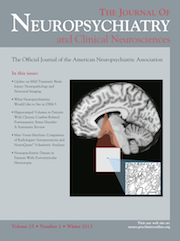Amisulpride-Induced Macrocytic Anemia
To the Editor: Amisulpride, an atypical antipsychotic used in treatment of both positive and negative symptoms of schizophrenia, has a benign adverse-effect profile.1 Commonly reported adverse effects include dose-related extrapyramidal syndromes, gastrointestinal, and sexual problems.2 A summary of product characteristics3 for amisulpride does not report any hematological toxicity. A PubMed search did not reveal any such association. We report a case of macrocytic anemia induced by amisulpride that reversed after discontinuation of the drug.
Case Report
The patient, a 29-year-old man, diagnosed with paranoid schizophrenia 10 years ago, presented with wandering behavior, suspiciousness, and unprovoked violence. Mental status revealed guarded attitude and constricted affect with grandiose and persecutory delusions. His mother had paranoid schizophrenia. His baseline investigations including complete hemogram; liver and renal function tests were normal. The patient responded to a combination of depot zuclopenthixol injection 200 mg every 3 weeks and olanzapine 7.5 mg/day without any emergent adverse effect. However, because of prominent negative symptoms, olanzapine was discontinued and tablet amisulpride 100 mg/day was added. After 2 months, he reported fatigability and, on examination, pallor was noted. Complete hemogram revealed macrocytic anemia (Hb 4.6 gm/dl; PCV 14.9%; MCV 119.2 fl; MCH 39.2 pg; MCHC 32.9%). There was no history of alcohol abuse, and nutritional status was adequate. His liver and renal function tests were within normal range. A possibility of amisulpride-induced macrocytic anemia was considered and the drug was discontinued, after which the affected hematological parameters normalized. A Naranjo ADR probability scale score of 4 suggested a possible association.4
Discussion
In our case, macrocytic anemia appeared within a few weeks of exposure to amisulpride, which improved after discontinuation of the suspected offending agent. Before initiation of amisulpride, baseline hematological indices were normal. There was no change in dietary intake during this period. Also, no folate or vitamin supplement was prescribed. Therefore, it is possible that amisulpride was the offending agent in our case.
Macrocytic anemia is commonly associated with folate and vitamin B12 deficiency, among others. Besides alcohol, drug-induced causes of macrocytic anemia include sulphasalazine, methotrexate, hydantoins, valproate, and oral contraceptives.5–8 Although the exact mechanism is not known, folate deficiency, either by inhibition of absorption or interference with metabolism, has been commonly hypothesized.8 A similar mechanism is likely to have caused macrocytic anemia in our case.
The recent edition of Meyler’s Side Effects of Psychiatric Drugs9 does not list any hematological adverse effects with amisulpride. Thus, our case study exemplifies that rare adverse effects, not previously reported in pre-marketing trials or post-marketing efficacy and safety studies, may occur during clinical use.
1 : Amisulpride a selective dopamine antagonist and atypical antipsychotic: results of a meta-analysis of randomized controlled trials. Int J Neuropsychopharmacol 2004; 7(Suppl 1):S15–S20Crossref, Medline, Google Scholar
2 : Safety of amisulpride (Solian): a review of 11 clinical studies. Int Clin Psychopharmacol 1999; 14:209–218Crossref, Medline, Google Scholar
3 : (Date of revision March 2008); available at http://www.sanofi-aventis.co.uk/products/Solian_SPC.pdf; accessed on July 29, 2011Google Scholar
4 : A method for estimating the probability of adverse drug reactions. Clin Pharmacol Ther 1981; 30:239–245Crossref, Medline, Google Scholar
5 : Megaloblastic anaemia produced by drugs. Clin Haematol 1976; 5:619–630Medline, Google Scholar
6 : Megaloblastic anaemia due to sulphasalazine responding to drug withdrawal alone. Postgrad Med J 1986; 62:307–308Crossref, Medline, Google Scholar
7 : Folic acid deficiency, megaloblastic anemia and peripheral polyneuropathy due to oral contraceptives. Isr J Med Sci 1989; 25:142–145Medline, Google Scholar
8 : Wintrobe’s Clinical Hematology, 12th Edition. Philadelphia, PA, Lippincott, Williams & Wilkins, 2009Google Scholar
9 : Meyler’s Side Effects of Psychiatric Drugs. Oxford, UK, Elsevier, 2009Google Scholar



